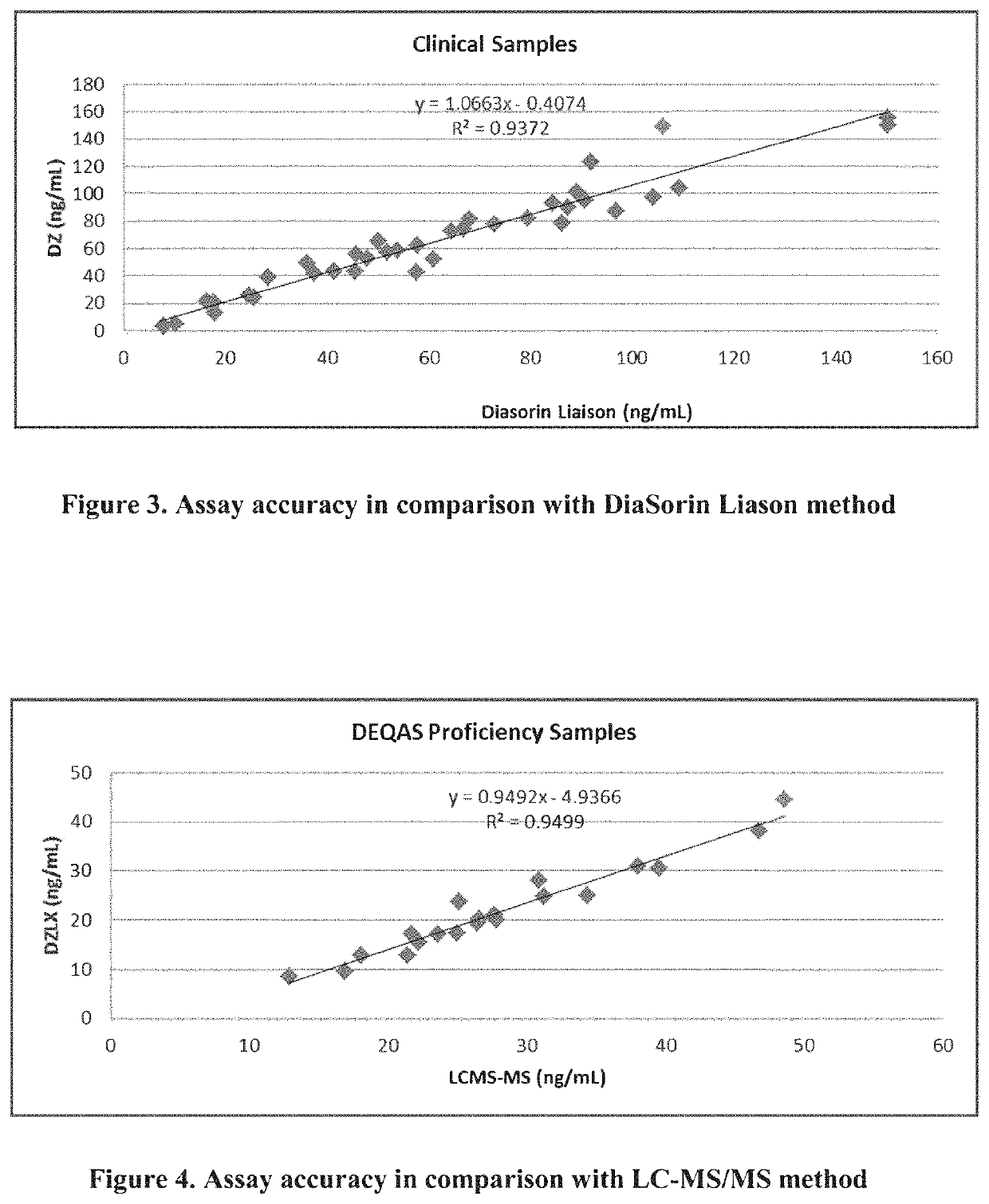Methods and kits for assaying a vitamin D moiety
a technology of vitamin d and moiety, which is applied in the field of vitamin d detection, can solve the problems of vitamin d deficiency, osteomalacia in adults, rickets in children,
- Summary
- Abstract
- Description
- Claims
- Application Information
AI Technical Summary
Benefits of technology
Problems solved by technology
Method used
Image
Examples
example 1
ssay Kit
[0158]The latex particle enhanced immunoassay reagents used in this example are listed below:
Reagent 1
0.05M Sodium Acetate, pH 4.0
10% NaCl
0.5% sugar
0.04% TWEEN 20
0.9% PEG 100k
0.09% NaN3
Reagent 2
0.6 M Tris, pH 8.0
0.1% BSA
10% Sucrose
0.2% TWEEN 20
0.05% first antibody-latex particle conjugate
0.08% second antibody-latex particle conjugate
0.09% NaN3
[0159]1. Assay Procedure with Beckman AU 680 Analyzer
[0160]Three (3) μL of sample was mixed with 16 μL of Reagent 1 inside a cuvette and incubated at 37° C. for about 3.5 min. Forty (40) μL of Reagent 2 was added to the mixture and incubated for about 4 min. The change in absorbance at 700 nm was measured using the assay parameters as indicated in the parameter sheet (Table 1) below. The assay procedure is also illustrated in FIG. 13.
[0161]
TABLE 1Assay Parameters on AU 680 analyzerGeneralTest Name: VITDType: SerumOperation: YesSample Volume 3.0 μlDilution 0 μlPre-Dilution Rate 1Reagents:Min ODMax ODRl volume ...
example 2
ssay Kit
[0169]Magnetic particle based chemiluminescent immunoassay reagents used are listed in this example:
[0170]Reagent 1:
[0171]0.05M Sodium Acetate buffer, pH 4.0
[0172]8% NaCl
[0173]1.2% Sucrose
[0174]0.05% TWEEN 20
[0175]0.09% NaN3
[0176]Reagent 2:
[0177]1×PBS buffer, pH 7.4
[0178]0.3% BSA
[0179]0.04% TWEEN 20
[0180]0.09% NaN3
[0181]0.1 mg / ml magnetic particles coated with the first antibody
[0182]Reagent 3:
[0183]1×PBS buffer, pH 8.0
[0184]0.2% BSA
[0185]0.04% TWEEN 20
[0186]1 ug / ml ABEI-labelled second antibody
[0187]NaN3 0.09%
[0188]Starter (Substrates):
[0189]a) 5% NaOH; b) 0.1% Peroxide
[0190]Washing Solution:
[0191]0.1 M Tris-HCl buffer and detergent.
[0192]Assay Procedure Using a Commercially Available Instrument:
[0193]Five ul (5 ul) of serum Sample was mixed with 180 ul of the Reagent 1, and incubate for 5 min to dissociate the vitamin D in the sample from its binding proteins. Aspirate 100 ul of the above sample / reagent 1 mixture, and mix with 20 ul of the Reagent 2, and incubate for 20 mi...
example 3
l Performance
[0197]a. Precision / Reproducibility
[0198]Precision of an exemplary Diazyme vitamin D assay (latex particle enhanced immunoassay in Example 1) was evaluated according to the Clinical and Laboratory Standards Institute (CLSI) EP5-A2 guideline. Precision assessment was performed on the Beckman AU680 chemistry analyzer. In the study, three lots of reagents were used. For each reagent lot, 12 specimens were tested: 2 vitamin D controls and 10 vitamin D human serum samples. The tested serum samples coming with IRB-approval were obtained from a commercial source (PromedDx) and covered the dynamic range of the assay. As recommended by the CLSI EP5-A2 protocol, precision samples were tested in duplicates per run and two runs per day over 20 working days. Eighty (80) data points were obtained per specimen and per reagent lot.
[0199]The precision results obtained for one representative lot of reagents is summarized Table 4 below.
[0200]
TABLE 4MeanWithin-RunTotalSample(N = 80)SD% CVSD...
PUM
| Property | Measurement | Unit |
|---|---|---|
| diameters | aaaaa | aaaaa |
| diameter | aaaaa | aaaaa |
| diameter | aaaaa | aaaaa |
Abstract
Description
Claims
Application Information
 Login to View More
Login to View More - R&D
- Intellectual Property
- Life Sciences
- Materials
- Tech Scout
- Unparalleled Data Quality
- Higher Quality Content
- 60% Fewer Hallucinations
Browse by: Latest US Patents, China's latest patents, Technical Efficacy Thesaurus, Application Domain, Technology Topic, Popular Technical Reports.
© 2025 PatSnap. All rights reserved.Legal|Privacy policy|Modern Slavery Act Transparency Statement|Sitemap|About US| Contact US: help@patsnap.com



